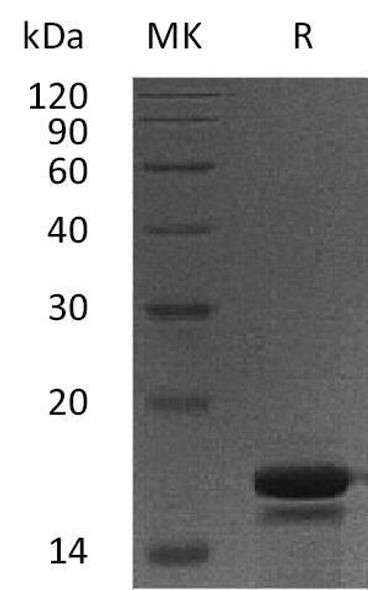Description
| Product Name: | Human PDCD5 Recombinant Protein |
| Product Code: | RPPB4210 |
| Size: | 20µg |
| Species: | Human |
| Target: | PDCD5 |
| Synonyms: | Programmed cell death protein 5, TF-1 cell apoptosis-related protein 19, Protein TFAR19, PDCD5, TFAR19, MGC9294. |
| Source: | Escherichia Coli |
| Physical Appearance: | Sterile Filtered colorless solution. |
| Formulation: | PDCD5 protein solution contains 1x PBS pH-7.4. |
| Stability: | Store at 4°C if entire vial will be used within 2-4 weeks. Store, frozen at -20°C for longer periods of time. For long term storage it is recommended to add a carrier protein (0.1% HSA or BSA).Avoid multiple freeze-thaw cycles. |
| Purity: | Greater than 95.0% as determined by SDS-PAGE. |
| Amino Acid Sequence: | MADEELEALR RQRLAELQAK HGDPGDAAQQ EAKHRGAEMR NSILAQVLDQ SARARLSNLA LVKPEKTKAV ENYLIQMARY GQLSEKVSEQ GLIEILKKVS QQTEKTTTVK LNRRKVMDSD EDDDY |
PDCD5 is expressed in tumor cells during apoptosis independent of the apoptosis-inducing stimuli. Prior to apoptosis induction, PDCD5 is distributed in both the nucleus and cytoplasm. Once apoptosis is induced, the amount of PDCD5 increases and by relocation from the cytoplasm, it accumulates in the nucleus.PDCD5 protein has a stable helical core conformation consisting of a triple-helix bundle and two dissociated terminal regions. PDCD5 is an important novel protein that regulates both apoptotic and non-apoptotic programmed cell death. PDCD5 functions in the process of apoptosis. PDCD5 plays an important role in regulation of apoptotic processes in gastric cancer cells and gastric tumors. PDCD5 plays a role in the pathogenesis of rheumatoid arthritis. -27G/-11A SNP is associated with reduced PDCD5 promoter activity and increased susceptibility to chronic myelogenous leukemia. PDCD5 gene may be a target gene under the control of some important apoptosis-related transcriptional factors during the cell apoptosis.
PDCD5 Recombinant produced in E.Coli is a single, non-glycosylated polypeptide chain containing 125 amino acids and having a molecular mass of 14 kDa.
| UniProt Protein Function: | PDCD5: May function in the process of apoptosis. Belongs to the PDCD5 family. |
| UniProt Protein Details: | Protein type:Apoptosis Chromosomal Location of Human Ortholog: 19q13.11 Cellular Component: cytoplasm; nucleus Molecular Function:heparin binding; protein binding; DNA binding; beta-tubulin binding Biological Process: negative regulation of cell proliferation; positive regulation of apoptosis; positive regulation of caspase activity |
| NCBI Summary: | This gene encodes a protein that is upregulated during apoptosis where it translocates rapidly from the cytoplasm to the nucleus. The encoded protein may be an important regulator of K(lysine) acetyltransferase 5 (a protein involved in transcription, DNA damage response and cell cycle control) by inhibiting its proteasome-dependent degradation. Pseudogenes have been identified on chromosomes 5 and 12 [provided by RefSeq, Dec 2010] |
| UniProt Code: | O14737 |
| NCBI GenInfo Identifier: | 6226219 |
| NCBI Gene ID: | 9141 |
| NCBI Accession: | O14737.3 |
| UniProt Related Accession: | O14737 |
| Molecular Weight: | |
| NCBI Full Name: | Programmed cell death protein 5 |
| NCBI Synonym Full Names: | programmed cell death 5 |
| NCBI Official Symbol: | PDCD5�� |
| NCBI Official Synonym Symbols: | TFAR19�� |
| NCBI Protein Information: | programmed cell death protein 5 |
| UniProt Protein Name: | Programmed cell death protein 5 |
| UniProt Synonym Protein Names: | TF-1 cell apoptosis-related protein 19; Protein TFAR19 |
| Protein Family: | Programmed cell death protein |
| UniProt Gene Name: | PDCD5�� |
| UniProt Entry Name: | PDCD5_HUMAN |






